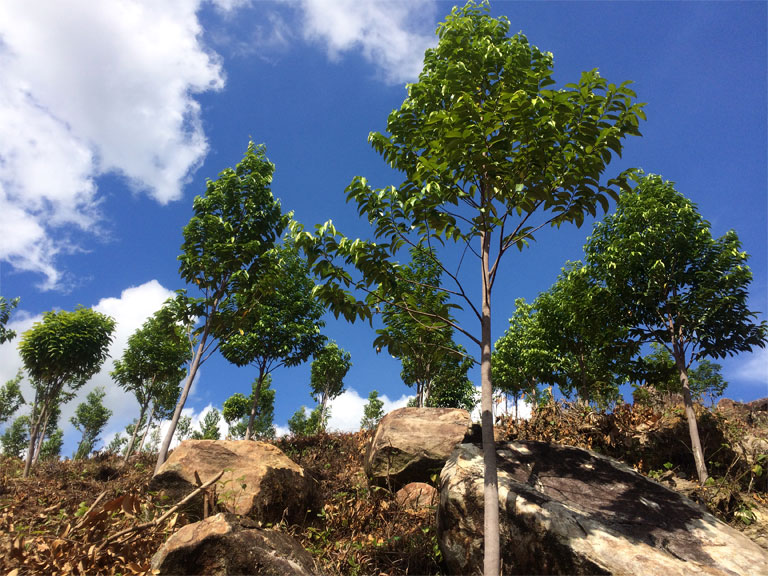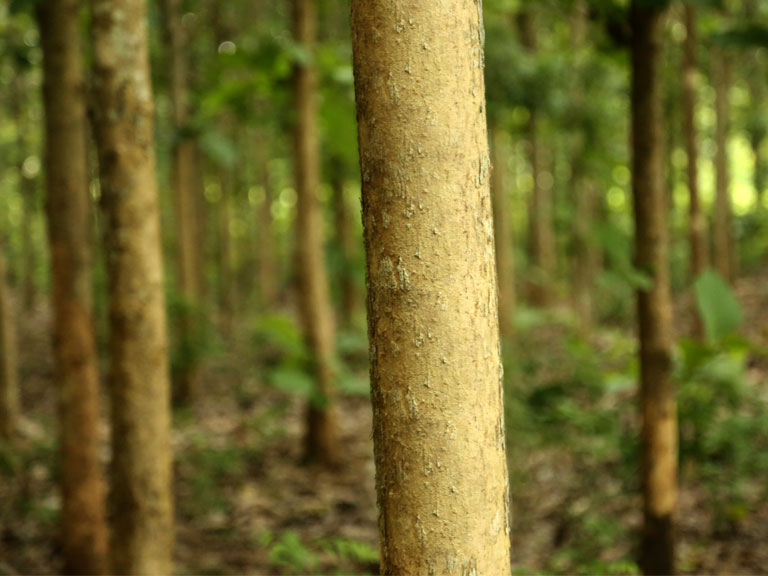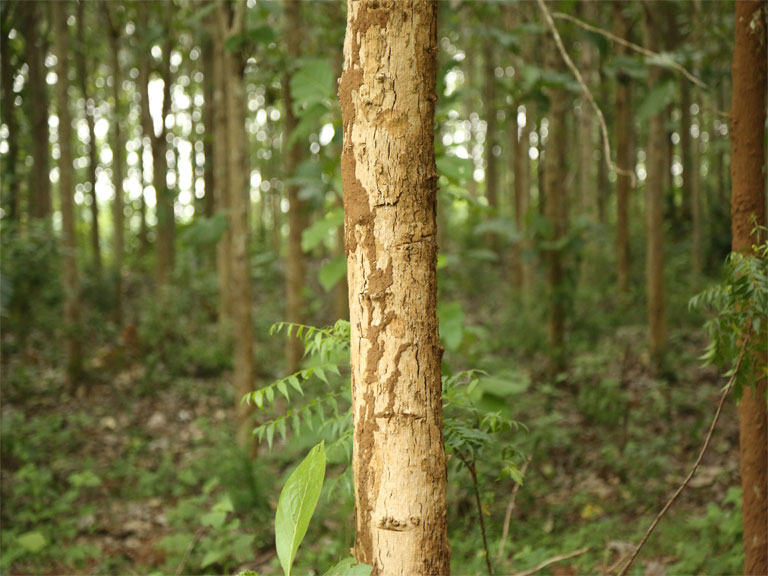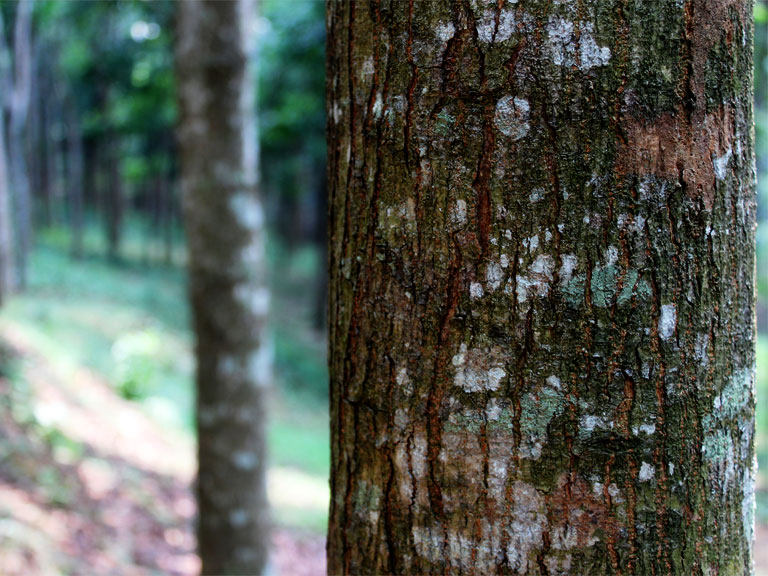R & D
Gyrinops walla, the newly found agarwood species: Variation of agarwood resin content and composition across a wider geographical coverage in Sri Lanka. 2nd International Scientific Symposium on Agarwood, University Putra Malaysia, Malaysia (10-12 October 2016).
Gyrinops walla, the newly found agarwood species: Variation of agarwood resin content and composition across a wider geographical coverage in Sri Lanka Subasinghe S.M.C.U.P.1*, de Alwis, W.N.H.1,2, Nawarathne B.S.2 and Hettiarachchi, D.S.
1*Department of Forestry & Environmental Science, University of Sri Jayewardenepura, Nugegoda, CO 10250, Sri Lanka 2Sadaharitha Plantations Limited, 6A Alfred Place, Colombo 03, CO 00300, Sri Lanka 3Wescorp Agarwood, Wescorp Group of Companies, 26, Coulson Way, Canning Vale, WA 6155, Australia The ability of producing agarwood resin in Gyrinops walla which is believed to be endemic to Sri Lanka, was scientifically discovered in 2012. Awareness made by this finding increased the willingness of the plantation sector to commercially cultivate G. walla in suitable areas. Since this species was not commercially cultivated previously, it is essential to identify the best conditions for growing it to earn income within a short time period. Therefore the present study attempted to identify the variation of agarwood resin contents and quality across a wider climate and geographical coverage of the country.
Nine locations of different elevations and rainfall patterns were selected from the areas where agarwood is growing naturally. Dark color agarwood resinous tissues formed due to natural causes were collected from 90 G. walla trees. Resin contents of those samples were determined by solvent extraction and resin compounds were analysed by Gas Chromatography-Mass Spectroscopy.
Although the average resin content varied from 1.95% to 4.92%, it was not significantly different between the tested locations. A relationship between rainfall and elevation could not be built with the resin content. However, the results revealed that there are higher variations within the trees of the same population than that of between populations. Solvent extracts found to contain a few semi-volatile 2(2-phenyl)chromones and fatty acids. Sesquiterpenes compounds identified from these samples were classified into six different types; agarofurans, vetispiranes, cadinanes, selinanes, guaianes and eremophilanes. However, the genetic differences and growth rates should be studied for arriving further conclusions.
Keyword: Agarwood resin, Agro-ecological region, Gyrinops walla, Sesquiterpenes.
Estimation of carbon storage of different forest plantations established by Sadaharitha Plantations Limited. International Symposium on Environment Management and Planning, Central Environmental Authority of Sri Lanka (23-24 February 2015) .
Estimation of Carbon Storage of Different Forest Plantations Established by Sadaharitha Plantations Limited
S.M.C.U.P. Subasinghe, B.S. Nawarathne[1], and U.N. Gunasekara1* Department of Forestry and Environmental Science, University of Sri Jayewardenepura, Nugegoda, CO 10250, Sri Lanka ABSTRACT: In order to mitigate the global warming resultant due to the rapid industrialisation, the “Green Economy Concept” has been introduced to the world which is defined by the United Nations Environmental Programme as one that results in improving human well-being and social equity, while reducing environmental risks and ecological scarcities. Therefore green economy leads to low emission of CO2 and similar gases and efficient resource utilisation with great social care.
Admiring the green economy concept, Sadaharitha Plantation Limited (SPL), the Gold Winner of Green Awards in 2012, engages in forest plantations management with Sandalwood, Teak, Mahogany, Rambutan and Agarwood to earn foreign income to the country. SPL manages its all plantations under ISO 14001 principles and Teak and Sandalwood plantations are being prepared to obtain Forest Certification. In addition, natural forest patches are maintained whenever possible in these plantations for the purpose of biodiversity conservation and landscape protection. In order to minimize the environmental damage due to the application of chemical fertilisers, over 1,500 MT of compost are annually made within the estates to use as organic fertiliser. Further, the company has provided over 900 direct green employment opportunities and introduced innovative forest-based income generation opportunities such as Agarwood Homegarden Concept to the villagers as a strategy to eliminate persistent poverty in Sri Lanka.
This paper investigates the carbon storage values of 156.0, 196.6, 3.4 and 13.9 ha of Sandalwood, (2 and 3 years old), Teak (2,3,4,5,6, and 7 years old), Mahogany (10 years old) and Rambutan (9 years old) plantations respectively managed by SPL in Colombo, Kalutara, Rathnapura, Puttlam, Badulla, Galle, Matale and Matara Districts. For this purpose, representative trees were selected from each species of each age and the tree volumes were estimated using appropriate volume functions. Then the carbon values were estimated using the guidelines of Carbon-Fix Standards V3.2 for each species. These values were then projected to 20 years after planting considering the growth rates and removal of trees in thinning.
According to the results, per hectare carbon storage values for 10 year old Mahogany plantations is 242.0 and 9 year old Rambutan plantations is 3.8 MT. The per hectare carbon values for 2 and 3 year old Sandalwood plantations are 0.1 and 0.6 MT while those values for 2, 3, 4, 5, 6 and 7 year old Teak plantations are 4.9, 9.7, 13.1, 23.4, 29.7 and 50.1 MT respectively. At the 20th year, the carbon contents of Mahogany, Rambutan, Sandalwood and Teak plantations will be 242.0, 41.3, 69.5 and 326.7 MT respectively which are equivalent to 887.2, 151.4, 254.78 and 1,197.7 respectively.
Keywords: Tree biomass, mahogany, sandalwood, teak, green economy [1] Sadaharitha Plantations Limited, 6A, Alfred Place, Colombo 03, CO 00300, Sri Lanka
* Corresponding author: info@sadaharitha.com
Santalum album distribution in Sri Lanka and the variation of oil contents and compounds. International Seminar on Sandalwood: Current Trends and Future Prospects, Institute of Wood Science and Technology, Bangalore, India (26-28 February 2014).
Santalum album distribution in Sri Lanka and the variation of oil contents and compounds
Subasinghe, S.M.C.U.P.1, Hettiarachchi, D.S.2, Nawarathne, B.S.3
1. Department of Forestry and Environmental Science, University of Sri Jayewardenepura, Nugegoda, Sri Lanka upul.forestry@gmail.com
2. Wescorp Sandalwood Pty Limited, 26, Coulson Way, Canning Vale, WA 6155, Australia
3. Sadaharitha Plantations Limited, 6A, Alfred Place, Colombo 03, Sri Lanka
ABSTRACT
Santalum album has a cultural and economic attraction mainly because of its fragrant oil produced in the heartwood. Due to this reason, the demand and value are increasing which has created a high market interest.
Early studies indicated that S. album showed a highly localized distribution in Sri Lanka. However, recent studies have proven that it has a wider distribution in the country. According to the literature, sandalwood oil content and quality vary within the trees growing in the same area. Therefore this study was designed to identify the oil content and oil quality variation in three districts of Sri Lanka, namely, Badulla, Kurunegala and Hambantota. All three districts belong to the Intermediate zone, however, with different rainfall, temperature and elevation figures.
Core samples and whenever possible, cross sections were extracted from randomly selected trees in each district. Oil was extracted by hydro-distillation and the different compounds present in oil were measured by gas chromatography analysis.
The results showed a large variation of oil contents present in the sampled trees. Selected oil compounds, i.e., cis-α-santalol, cis-β-santalol, epi-β-bisabalol, epi-β-santalol and t,t-farnesol showed little or no variation between the three selected districts. However, cis-t-bergamotol was high in the sampled trees of Hambantota district. Those compounds did not have significant correlations with tree parameters, geographic and topographic parameters, i.e., dbh, heath and heartwood content. Key words: Santalum album, oil quantity, oil constituents, cis-α-santalol
Agarwood resin production of Gyrinops walla: A new finding. 1st International Scientific Symposium, University Putra Malaysia, Malaysia (03-05 September 2013).
Agarwood resin production of Gyrinops walla: A new finding Subasinghe, S.M.C.U.P.
1*, Hettiarachchi, D.S2 and Nawarathne, B.S.3 1* Department of Forestry and Environmental Science, University of Sri Jayewardenepura, Nugegoda, CO 10250, Sri Lanka
2 Wescorp Agarwood, 26, Coulson Way, Canning Vale, WA 6155, Australia
3 Sadaharitha Plantations Limited, 6A, Alfred Place, Colombo 03, CO 00300, Sri Lanka
Gyrinops walla, a member of the agarwood family Thymelaeaceae is recorded in the wet zone of Sri Lanka has not been previously studied to identify its ability of producing agarwood. Therefore the present study was the first ever to conduct to identify the production of agarwood resins in G. walla and its resin quality.
Three distinctive areas of the low country wet zone of Sri Lanka were selected for this study and 22 G. walla trees were used for sample collection. Since there were no artificial resin induction methods applied earlier, all selected trees had natural wounds occurred sometime before the sample collection due to natural injuries. The dark coloured tissues of the affected areas were collected without felling the trees and the resins were extracted by a solvent extraction method. The diameter and height of the sampled trees were measured and the geographical positions were also recorded. The extracted resins were further analysed by using gas chromatography technique to identify the different compounds and to compare those compounds with that of selected Aquilaria species.
The agarwood resin contents of the selected samples varied from 0.26% to 14.45% (w/w) irrespective of the tree size. Gas chromatography analysis revealed that the tested samples contained several aroma principles commonly found in agarwood. It was further revealed a strong similarity of those resin compounds with that of the selected Aquilaria species. With this finding, further studies are suggested to identify the most appropriate artificial methods to induce the agarwood production in G. walla to utilise it for commercial purposes.
Key words: Agarwood, Aquilaria, Gyrinops walla, solvent extraction, Sri Lanka
Santalum album: Current status and research conducted in Sri Lanka. International Sandalwood Symposium, University of Hawaii, Honolulu, Hawaii (21-24 October 2012).
Santalum album: Current status and research conducted in Sri Lanka S.M.C.U.P. Subasinghe1, B.S. Nawarathne2, D.S. Hettiarachchi3
Department of Forestry and Environmental Science, University of Sri Jayewardenepura, Sri Lanka
Sadaharitha Plantations Limited, 6A, Alfred Place, Colombo 03, Sri Lanka
Wescorp Sandalwood Pty Limited, 26, Coulson Way, Canning Vale, WA 6155, Australia
Santalum album is a native plant of Sri Lanka and its value and quality have been used to show the characteristics of good in the ancient literature. It naturally distributes in the area where mean annual the temperature is between 22.5-25.0 0C; mean annual rainfall is between 1,000-1,500 mm; and at the elevation between 500-1,000 m above mean sea level. However, recent research has proven that S. album grows in wider climatic and elevation regions than the above with a growth rate of 0.3 to 1.0 cm of dbh and 0.3 to 1.0 m of height per year. S. album has been listed as a protected species in Sri Lanka under the Flora and Fauna Act of 1964 and again with the recent amendment of the year 2009.
Felling and harvesting have become a lengthy procedure due to this reason and therefore planting is unpopular among the general public. The major threat to the existing trees is the illegal harvesting which heavily caused the resource depletion. Due to the severity of the illegal harvesting, protection has become useless and owners tend to sell trees before the maturity. However, establishment of commercial S. album plantations has become popular and fast growing among the private sector since recent years.
This activity became accelerated since 2010 as one company started establishing plantations in different climatic zones of Sri Lanka after some silvicultural studies. Limited availability of lands, poor land quality and poor access to the available lands are the current problems faced in establishing such plantations. For the existing S. album plantations, Altenanthera is used as seedling host and Sesbenia grandiflora and Gliricidia sepium are used as medium-term hosts. S. album research has been stated recently in Sri Lanka and studies on oil quantity and quality, seed germination and seedling hosts were already completed.
Recognising the value of S. album research, in December 2012, the government of Sri Lanka has funded a three-year research project through the National Research Council in collaboration with University of Sri Jayewardenpura and Sadaharitha Plantations Limited, Sri Lanka and Curtin University of Technology and Wescorp Sandalwood Pty Limited in Western Australia to further study on medium and long-term hosts and santalol quantity and quality of the trees growing in different agro-ecological zones. The results of this study will reveal the most suitable medium and long-term hosts for different regions of the country and will test the relationships between santalol quantity and quality with climatic, geographic and topographic variations.
















